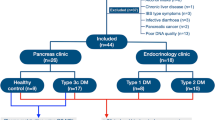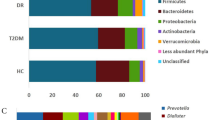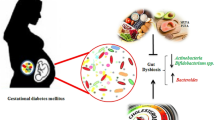Abstract
Bacteria associated with the onset of type 1 diabetes in a rat model system were identified. In two experiments, stool samples were collected at three time points after birth from bio-breeding diabetes-prone (BB-DP) and bio-breeding diabetes-resistant (BB-DR) rats. DNA was isolated from these samples and the 16S rRNA gene was amplified using universal primer sets. In the first experiment, bands specific to BB-DP and BB-DR genotypes were identified by automated ribosomal intergenic spacer analysis at the time of diabetes onset in BB-DP. Lactobacillus and Bacteroides strains were identified in the BB-DR- and BB-DP-specific bands, respectively. Sanger sequencing showed that the BB-DP and BB-DR bacterial communities differed significantly but too few reads were available to identify significant differences at the genus or species levels. A second experiment confirmed these results using higher throughput pyrosequencing and quantitative PCR of 16S rRNA with more rats per genotype. An average of 4541 and 3381 16S rRNA bacterial reads were obtained from each of the 10 BB-DR and 10 BB-DP samples collected at time of diabetes onset. Nine genera were more abundant in BB-DP whereas another nine genera were more abundant in BB-DR. Thirteen and eleven species were more abundant in BB-DP and BB-DR, respectively. An average of 23% and 10% of all reads could be classified at the genus and species levels, respectively. Quantitative PCR verified the higher abundance of Lactobacillus and Bifidobacterium in the BB-DR samples. Whether these changes are caused by diabetes or are involved in the development of the disease is unknown.
Similar content being viewed by others
Log in or create a free account to read this content
Gain free access to this article, as well as selected content from this journal and more on nature.com
or
Accession codes
Accessions
GenBank/EMBL/DDBJ
References
Altschul S, Madden T, Schaeffer A, Zhang J, Zhang Z, Miller W et al. (1997). Gapped BLAST and PSI-BLAST: a new generation of protein database search programs. Nucleic Acids Res 25: 3389–3402.
Bernet-Camard MF, Lie'vin V, Brassart D, Neeser JR, Servin AL, Hudault S . (1997). The human Lactobacillus acidophilus strain LA1 secretes a nonbacteriocin antibacterial substance(s) active in vitro and in vivo. Appl Environ Microbiol 63: 2747–2753.
Bosshard PP, Stettler R, Bachofen R . (2000). Seasonal and spatial community dynamics in the meromictic Lake Cadagno. Arch Microbiol 174: 168–174.
Brugman S, Klatter FA, Visser JTJ, Wildeboer-Veloo ACM, Harmsen HJM, Rozing J et al. (2006). Antibiotic treatment partially protects against type 1 diabetes in the bio-breeding diabetes-prone rat. Is the gut flora involved in the development of type 1 diabetes? Diabetologia 49: 2105–2108.
Byun R, Nadkarni MA, Chhour KL, Martin FE, Jacques NA, Hunter N . (2004). Quantitative analysis of diverse Lactobacillus species present in advanced dental caries. J Clin Microbiol 42: 3128–3136.
Calcinaro F, Dionisi S, Marinaro M, Candeloro P, Bonato V, Marzotti S et al. (2005). Oral probiotic administration induces interleukin-10 production and prevents spontaneous autoimmune diabetes in the non-obese diabetic mouse. Diabetologia 48: 1565–1575.
Čepeljnik T, Lah B, Narat M, Marinšek-Logar R . (2007). Adaptation of adhesion test using caco-2 cells for anaerobic bacterium Pseudobutyrivibrio xylanivorans, a probiotic candidate. Folia Microbiol (Praha) 52: 367–373.
Čepeljnik T, Zorec M, Kostanjsek R, Nekrep FV, Marinsek-Logar R . (2003). Is Pseudobutyrivibrio xylanivorans strain Mz5T suitable as a probiotic? An in vitro study. Folia Microbiol (Praha) 48: 339–345.
Delroisse JM, Boulvin AL, Parmentier I, Dauphin RD, Vandenbol M, Portetelle D . (2008). Quantification of Bifidobacterium spp. and Lactobacillus spp. in rat fecal samples by real-time PCR. Microbiol Res 163: 663–670.
DeSantis TZ, Hugenholtz P, Keller K, Brodie EL, Larsen N, Piceno YM et al. (2006). NAST: a multiple sequence alignment server for comparative analysis of 16S rRNA genes. Nucleic Acids Res 34: W394–W399.
Edgar RC . (2004). MUSCLE: multiple sequence alignment with high accuracy and high throughput. Nucleic Acids Res 32: 1792–1797.
Elder ME, Maclaren N . (1983). Identification of profound peripheral T lymphocyte immunodeficiencies in the spontaneously diabetic BB rat. J Immunol 130: 1723–1731.
Fisher MM, Triplett EW . (1999). Automated approach for ribosomal intergenic spacer analysis of microbial diversity and its application to freshwater bacterial communities. Appl Environ Microbiol 65: 4630–4636.
Fukuda S, Suzuki Y, Murai M, Asanuma N, Hino T . (2006). Isolation of a novel strain of Butyrivibrio fibrisolvens that isomerizes linoleic acid to conjugated linoleic acid without hydrogenation, and its utilization as a probiotic for animals. J Appl Microbiol 100: 787–794.
Greiner DL, Rossin AA, Mordes JP . (2001). Translating data from animal models into methods for preventing human autoimmune diabetes mellitus: caveat emptor and primum non nocere. Clin Immunol 100: 134–143.
Hamady M, Walker J, Harris JK, Gold NJ, Knight R . (2008). Error-correcting barcoded primers for pyrosequencing hundreds of samples in multiplex. Nat Methods 5: 235–237.
Hooper LV . (2004). Bacterial contributions to mammalian gut development. Trends Microbiol 12: 129–134.
Hooper LV, Gordon JI . (2001). Commensal host-bacterial relationships in the gut. Science 292: 1115–1118.
Huang X, Wang J, Aluru S, Yang SP, Hillier L . (2003). PCAP: a whole-genome assembly program. Genome Res 13: 2164–2170.
Hughes JB, Hellmann JJ, Ricketts TH, Bohannan BJM . (2001). Counting the uncountable: statistical approaches to estimating microbial diversity. Appl Environ Microbiol 67: 4399–4406.
Iwakoshi NN, Greiner DL, Rossini AA, Mordes JP . (1999). Diabetes prone BB rats are severely deficient in natural killer T cells. Autoimmunity 31: 1–14.
Jack RW, Tagg JR, Ray B . (1995). Bacteriocins from Gram-positive bacteria. Microbiol Rev 59: 171–200.
Klaenhammer T, Altermann E, Arigoni F, Bolotin A, Breidt F, Broadbent J et al. (2002). Discovering lactic acid bacteria by genomics. Antonie Van Leeuwenhoek 82: 29–58.
Leahy SC, Higgins DG, Fitzgerald GF, van Sinderen D . (2005). Getting better with bifidobacteria. J Appl Microbiol 98: 1303–1315.
Li W, Godzik A . (2006). Cd-hit: a fast program for clustering and comparing large sets of protein or nucleotide sequences. Bioinformatics 22: 1658–1659.
Like AA, Guberski DL, Butler L . (1991). Influence of environmental viral agents on frequency and tempo of diabetes-mellitus in BB/WOR rats. Diabetes 40: 259–262.
Lorca GL, Wadstrom T, de Valdez GF, Ljungh A . (2001). Lactobacillus acidophilus autolysins inhibit Helicobacter pylori in vitro. Curr Microbiol 42: 39–44.
Lozupone C, Hamady M, Knight R . (2006). UniFrac—an online tool for comparing microbial community diversity in a phylogenetic context. BMC Bioinformatics 7: 371.
Makarova K, Slesarev A, Wolf Y, Sorokin A, Mirkin B, Koonin E et al. (2006). Comparative genomics of the lactic acid bacteria. Proc Natl Acad Sci USA 103: 15611–15616.
Mai V, Colbert LH, Perkins SN, Schatzkin A, Hursting SD . (2007). Intestinal microbiota: a potential diet-responsive prevention target in ApcMin mice. Mol Carcinog 46: 42–48.
Martin B, Jofré A, Garriga M, Pla M, Aymerich T . (2006). Rapid quantitative detection of Lactobacillus sakei in meat and fermented sausages by real-time PCR. Appl Environ Microbiol 72: 6040–6048.
Matsuzaki T, Nagata Y, Kado S, Uchida K, Kato I, Hashimoto S et al. (1997). Prevention of onset in an insulin-dependent diabetes mellitus model, NOD mice, by oral feeding of Lactobacillus casei. APMIS 105: 643–649.
Mazmanian SK, Liu CH, Tzianabos AO, Kasper DL . (2005). An immunomodulatory molecule of symbiotic bacteria directs maturation of the host immune system. Cell 122: 107–118.
McInerney MF, Pek SB, Thomas DW . (1991). Prevention of insulitis and diabetes onset by treatment with complete Freund's adjuvant in NOD mice. Diabetes 40: 715–725.
Mordes JP, Bortell R, Blankenhorn EP, Rossini AA, Greiner DL . (2004). Rat models of type 1 diabetes: genetics, environment, and autoimmunity. ILAR J 45: 278–291.
Neu J, Reverte CM, Mackey AD, Liboni K, Tuhacek-Tenace LM, Hatch M et al. (2005). Changes in intestinal morphology and permeability in the biobreeding rat before the onset of type 1 diabetes. J Pediatr Gastroenterol Nutr 40: 589–595.
Ohkawara S, Furuya H, Nagashima K, Asanuma N, Hino T . (2005). Oral administration of Butyrivibrio fibrisolvens, a butyrate-producing bacterium, decreases the formation of aberrant crypt foci in the colon and rectum of mice. J Nutr 135: 2878–2883.
Ohkawara S, Furuya H, Nagashima K, Asanuma N, Hino T . (2006). Effect of oral administration of Butyrivibrio fibrisolvens MDT-1 on experimental enterocolitis in mice. Clin Vaccine Immunol 13: 1231–1236.
Ranjard L, Poly LF, Lata JC, Mougel C, Thioulouse J, Nazaret S . (2001). Characterization of bacterial and fungal soil communities by automated ribosomal intergenic spacer analysis fingerprints: biological and methodological variability. Appl Env Microbiol 67: 4479–4487.
Reid G, Jass J, Sebulsky MT, McCormick JK . (2003). Potential uses of probiotics in clinical practice. Clin Microbiol Rev 4: 658–672.
Roesch LFW, Fulthorpe RR, Riva A, Casella G, Hadwin AKM, Kent AD et al. (2007). Pyrosequencing enumerates and contrasts soil microbial diversity. ISME J 1: 283–290.
Sadelain MWJ, Qin HY, Lauzon J, Singh B . (1990a). Prevention of type-1 diabetes in NOD mice by adjuvant immunotherapy. Diabetes 39: 583–589.
Sadelain MWJ, Qin HY, Sumoski W, Parfeny N, Singh B, Rabinovitch A . (1990b). Prevention of diabetes in the BB rat by early immunotherapy using Freund adjuvant. J Autoimmunity 3: 671–680.
Salminen S, Benno Y, de Vos W . (2006). Intestinal colonisation, microbiota and future probiotics? Asia Pac J Clin Nutr 15: 558–562.
Schwartz RF, Neu J, Schatz D, Atkinson MA, Wasserfall C . (2007). Comment on: Brugman S (2006). Antibiotic treatment partially protects against type 1 diabetes in the bio-breeding diabetes-prone rat. Is the gut flora involved in the development of type 1 diabetes? Diabetologia 49: 2105–2108. Diabetologia 50: 220–221.
Silva M, Jacobus NV, Deneke C, Gorbach SL . (1987). Antimicrobial substance from a human Lactobacillus strain. Antimicrob Agents Chemother 31: 1231–1213.
Stappenbeck TS, Hooper LV, Gordon JI . (2002). Developmental regulation of intestinal angiogenesis by indigenous microbes via Paneth cells. Proc Natl Acad Sci USA 99: 15451–15455.
Suzuki T, Yamada T, Fujimura T, Kawamura E, Shimizu M Yamashita R . (1987). Diabetogenic effects of lymphocyte transfusion on the NOD or NOD nude mouse. In: Rygaard J, Brunner N, Groem N, Spang-Thomsen M (eds). Immune-Deficient Animals in Biomedical Research, Copenhagen 1985. Karger: Basel, pp 112–116.
Tamura K, Dudley J, Nei M, Kumar S . (2007). MEGA4: Molecular Evolutionary Genetics Analysis (MEGA) software version 4.0. Mol Biol Evol 24: 1596–1599.
Thompson JD, Gibson TJ, Plewniak F, Jeanmougin F, Higging DG . (1997). The CLUSTAL-X windows interface: flexible strategies for multiple sequence alignment aided by quality tools. Nucleic Acids Res 25: 4876–4882.
Vaarala O, Atkinson MA, Neu J . (2008). The ‘perfect storm’ for type 1 diabetes: the complex interplay between intestinal microbiota, gut permeability, and mucosal immunity. Diabetes 57: 2555–2562.
Vandenbergh PA . (1993). Lactic acid bacteria, their metabolic products and interference with microbial growth. FEMS Microbiol Rev 12: 221–238.
Wicker LS, Miller BJ, Coker LZ, McNally SE, Scott S, Mullen Y et al. (1987). Genetic control of diabetes and insulitis in the nonobese diabetic (NOD) mouse. J Exp Med 165: 1639–1654.
Yadav H, Shalini J, Sinha PR . (2007). Antidiabetic effect of probiotic dahi containing Lactobacillus acidophilus and Lactobacillus casei in high fructose fed rats. Nutrition 23: 62–68.
Acknowledgements
This work was funded by the National Institutes of Health (RO3 A142288), the Brehm Coalition and the Florida Agricultural Experiment Station. We thank Biomedical Research Models, Inc. (Worcester, MA, USA) for providing all of the fecal samples used in this work.
Author information
Authors and Affiliations
Corresponding author
Additional information
Supplementary Information accompanies the paper on The ISME Journal website (http://www.nature.com/ismej)
Supplementary information
Rights and permissions
About this article
Cite this article
Roesch, L., Lorca, G., Casella, G. et al. Culture-independent identification of gut bacteria correlated with the onset of diabetes in a rat model. ISME J 3, 536–548 (2009). https://doi.org/10.1038/ismej.2009.5
Received:
Revised:
Accepted:
Published:
Issue date:
DOI: https://doi.org/10.1038/ismej.2009.5
Keywords
This article is cited by
-
Gut microbiota in pancreatic diseases: possible new therapeutic strategies
Acta Pharmacologica Sinica (2021)
-
Oral therapy with colonization factor antigen I prevents development of type 1 diabetes in Non-obese Diabetic mice
Scientific Reports (2020)
-
Association of prevalent vaginal microbiome of mother with occurrence of type I diabetes in child
Scientific Reports (2019)
-
Probiotic properties of Lactobacillus strains with high cinnamoyl esterase activity isolated from jeot-gal, a high-salt fermented seafood
Annals of Microbiology (2019)
-
Human milk oligosaccharides protect against the development of autoimmune diabetes in NOD-mice
Scientific Reports (2018)



